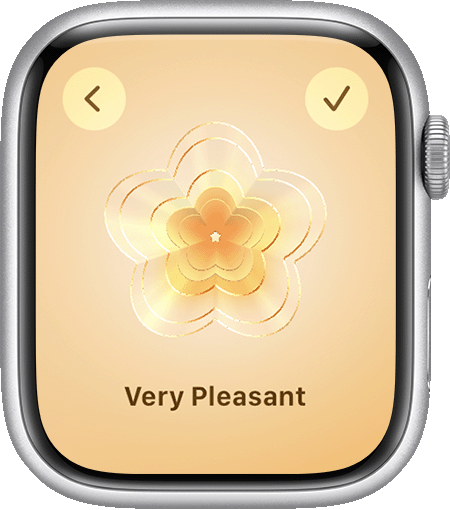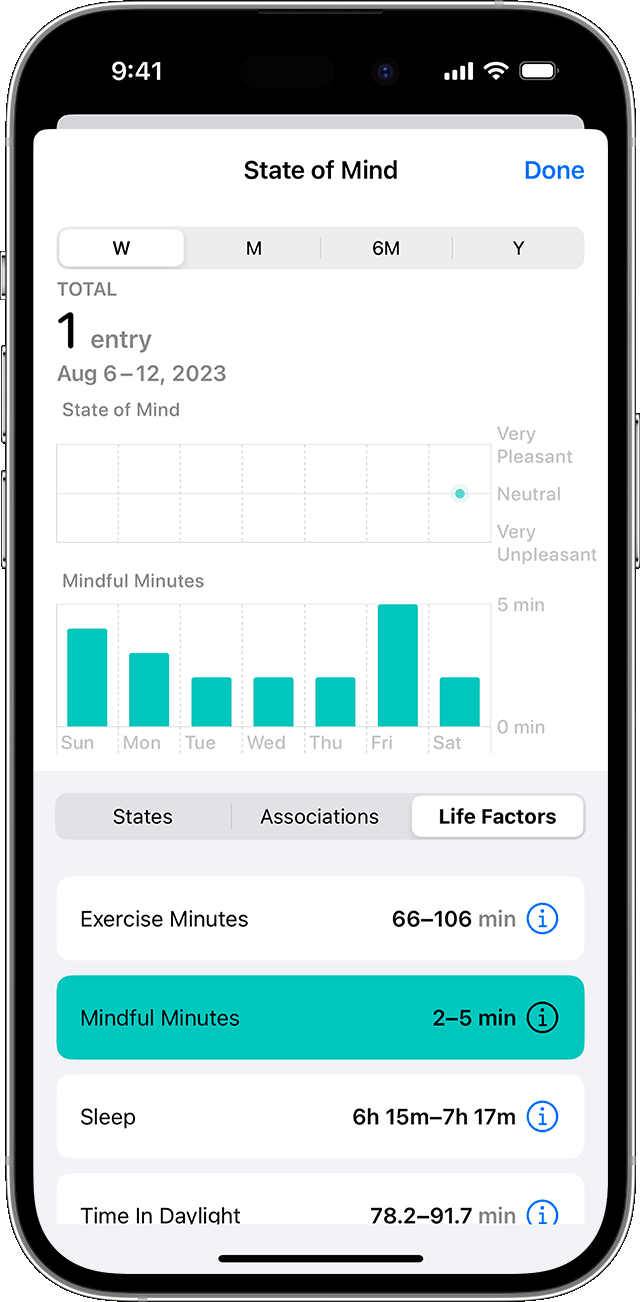Log your moods and emotions and take mental health assessments
Track your mental wellbeing by logging your moods and emotions and by taking standardized mental health assessments to understand your current risk of depression and anxiety. If you have concerns about your mental health, consult a clinician.
Log an Emotion or Mood
You can choose between logging an emotion you're feeling right now or your overall mood for the day.
On your iPhone or iPad
Open the Health app.
If you're on your iPhone, tap Browse. If you're on your iPad, tap to open the sidebar.
Tap Mental Wellbeing, then tap State of Mind.
If this is your first time logging, tap Get Started. Otherwise, tap Log.
Select Emotion to log how you're feeling right now or Mood to log how you've felt overall today.

Drag the slider to select how you're feeling, then tap Next.
Tap any optional words that best describe this feeling, then tap Next.
Tap any optional words for what has the biggest impact on you, then tap Done.
On your Apple Watch
Open the Mindfulness app.
Tap State of Mind, then tap Log how you're feeling right now or Log how you've felt overall today.

Turn the Digital Crown to select a feeling, then tap the checkmark in the upper-right.
Select any optional words that best describe this feeling, then tap the checkmark in the upper-right.
Select any optional words for what has the biggest impact on you, then tap the checkmark in the upper-right.
Turn on reminders
On your iPhone, open the Health app, then tap Browse.
Tap Mental Wellbeing, then tap State of Mind.
Scroll down and tap Options.
Choose to be reminded During Your Day, at the End of Day, or you can tap Add Reminder to set a specific time.

You can also tap Manage Mindfulness in Apple Watch App to adjust your reminders for your Apple Watch.
To help build a habit of logging your moods and emotions, add the Health widget to your iPhone or the Mindfulness complication to your Apple Watch. Learn how to add widgets to your Lock Screen and customize the watch face.
Complete a mental health assessment
Mental health assessments are available to help you understand your current risk of depression and anxiety.
From your iPhone or iPad, open the Health app.
If you're on your iPhone, tap Browse. If you're on your iPad, tap to open the sidebar.
Tap Mental Wellbeing.
Under Get More From Health, tap Take Questionnaire. If you've previously completed an assessment, tap Anxiety Risk or Depression Risk, then tap Take Questionnaire.
Confirm your age, then tap Begin.

Select your answers to the questions, then tap Done.
The depression assessment is called Patient Health Questionnaire-9 (PHQ-9) and anxiety assessment is called Generalized Anxiety Disorder-7 (GAD-7). The PHQ-9 and GAD-7 were developed by Drs. Robert L. Spitzer, Janet B.W. Williams, Kurt Kroenke and colleagues, with an educational grant from Pfizer Inc.The assessments are provided in the Health app for informational purposes only and the results are not a medical diagnosis.
Learn more about using mental health assessments
View and share insights into your mental wellbeing
From your iPhone or iPad:
Open the Health app.
If you're on your iPhone, tap Browse. If you're on your iPad, tap to open the sidebar.
Tap Mental Wellbeing, then tap State of Mind.
Tap Show in Charts.
Tap States, Associations, or Life Factors to view your previous logs, factors associated with your logs, or life factors such as Exercise Minutes, Mindful Minutes, Sleep, or Time In Daylight which might impact your mental wellbeing.

If you securely share your health data, you can choose to share your Anxiety Risk, Depression Risk, and State of Mind with friends and family. Learn more about how to share and view health data in the Health app.
Delete a mood or emotion log or an assessment
If you incorrectly logged a mood or emotion or inaccurately completed an assesment, you can delete it.
On your iPhone or iPad, open the Health app.
If you're on your iPhone, tap Browse. If you're on your iPad, tap to open the sidebar.
Tap Mental Wellbeing.
If you need to delete an emotion or mood log, tap State of Mind. If you need to delete an assessment, tap Anxiety Risk or Depression Risk.
Scroll down and tap Show All Data.
Tap Edit in the upper-right corner.
Tap the red next to the entry or entries you want to delete. You can also tap Delete All.

Tap Done.
Turn off prompts for questionnaires
If you don't want to be prompted to take a mental health assessment a couple of times a year, or when you have a pattern of unpleasant moods, you can turn off Periodic Questionnaires and Unpleasant Logging.
On your iPhone or iPad, open the Health app.
If you're on your iPhone, tap Browse. If you're on your iPad, tap to open the sidebar.
Tap Mental Wellbeing, then tap Anxiety Risk or Depression Risk.
Scroll down and tap Options.
Turn off Periodic Questionnaires and Unpleasant Logging.
About the privacy of your health data
The information you add about yourself in the Health app is yours to use and share. You can decide what information is placed in the Health app, as well as who can access your data.
When your phone or iPad is locked with a passcode, Touch ID, or Face ID, all of your health and fitness data in Health app, other than your Medical ID, is encrypted. Any health data synced to iCloud is encrypted both in transit and on our servers, and if you have a recent version of watchOS and iOS with the default two-factor authentication and a passcode, your health and activity data will be stored in a way that Apple can't read it.
This means that when you use the Mental Wellbeing features and have enabled two-factor authentication, your health data synced to iCloud is encrypted end-to-end and Apple does not have the key to decrypt the data and therefore cannot read it.
No clinician will follow up with you upon completion of the mental health assessments.